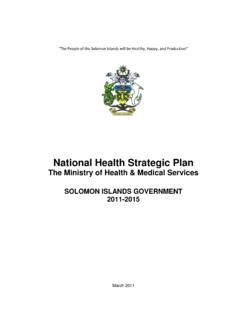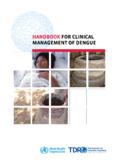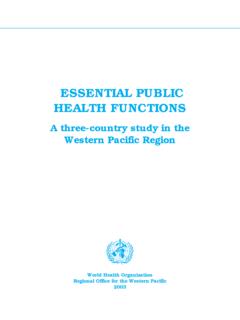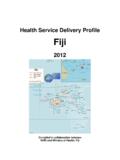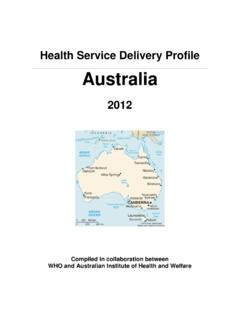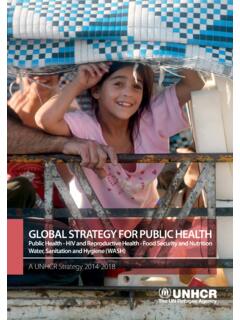Transcription of PHILIPPINE NATIONAL TOBACCO CONTROL STRATEGY …
1 PHILIPPINE NATIONAL . TOBACCO CONTROL STRATEGY (2011-2016). CONTENTS. PHILIPPINE NATIONAL TOBACCO CONTROL STRATEGY . 6 DEPARTMENT OF HEALTH (DOH) - PHILIPPINES. EXECUTIVE SUMMARY. N oncommunicable diseases (NCDs) are de ned as diseases of long duration and are generally slow in progression. They are the leading causes of adult mortality and mor- bidity The UN Member States recognize the challenge imposed by noncommunicable diseases (NCDs) rising in epidemic proportion and having a direct impact on social and economic development, contributing to poverty, and threatening the achievement of Millennium De- velopment Goals (MDGs). In September 2011, the UN Summit on NCDs released a statement in the Political Declaration of the United Nation on the Prevention and CONTROL of Noncom- municable Diseases,' where member States realized the need to tackle cancer and other NCDs on a global scale.
2 Among the interventions identi ed were the multi-sectoral re- sponses and the integration of NCD policies and programmes into the broader health and development In the Philippines, chronic noncommunicable diseases also dominate the major causes of death. In 2004, the Department of Health (DOH) data3 showed that the ten top causes of deaths were diseases of the heart; diseases of the vascular system; malignant neoplasm;. pneumonia; accidents; tuberculosis; chronic lower respiratory diseases; diabetes mellitus;. certain conditions originating in the perinatal period; and nephritis and nephrosis. Among these, TOBACCO contributes to, or aggravates all of the causes except for accidents and ne- 1. Noncommunicable Diseases in the Southeast Asia Region: 2011 Situation and Response 2. UN Summit on NCDs-Political Declaration, September 2011.
3 3. Health Statistics, Department of Health (DOH-NEC 2004). 4. TOBACCO in the Philippines: Comprehensive Country Pro le (Draft.) July 2010. PHILIPPINE NATIONAL TOBACCO CONTROL STRATEGY 7. Globally, TOBACCO use is the leading preventable cause of death and its effects health, social, and economic are devastating. In the Philippines, the annual productivity losses from prema- ture deaths for four smoking-related diseases - lung cancer, cardiovascular diseases, coronary artery disease, and chronic obstructive pulmonary diseases ranged from US$ million to US$ billion using the conservative Peto-Lopez estimates ( TOBACCO and Poverty Study in the Philippines, GATS 2009). If current global trends continue, it is likewise estimated that to- bacco will kill more than eight million people annually by 2030, with three-quarters of deaths being in low and middle-income According to the World Health Organization (WHO), one-third of the world's smokers reside in the Western Paci c Region (WPR), which comparatively has the greatest number of smokers among the other ve WHO The Philippines, being a TOBACCO -growing country, is one of the countries in the Western Paci c Region with high prevalence of TOBACCO use.
4 The 2009. Philippines Global Adult TOBACCO Survey (GATS) shows that overall, ( million) of the population aged 15 years old and over in the Philippines currently smoke The Philippines started TOBACCO CONTROL efforts in 1987 and since then, despite the strong lob- bying of the TOBACCO industry, the country successfully passed the Republic Act 9211 (Tobac- co Regulation Act of 2003) on June 23, 2003 as the rst comprehensive NATIONAL legislation on TOBACCO CONTROL . Among the main thrusts of the law are: (a) Promotion of a healthful envi- ronment; (b) Dissemination of information regarding the health risks associated with TOBACCO use; (c) Regulation and subsequent ban of all TOBACCO advertisements and sponsorships; (d). Regulation of the labeling of TOBACCO products; and (e) Protection of the youth from starting a life-long addiction to TOBACCO use by prohibiting the sale of TOBACCO products to minors.
5 The WHO WPR had also developed the rst Regional Action Plan (RAP 1990-1994) for the TOBACCO Free Initiative in the early 90s. Since then, there has been a continuous progress in TOBACCO CONTROL initiative in the Region highlighted by the entry into force of the WHO Frame- work Convention on TOBACCO CONTROL (WHO-FCTC) in 2005. The Philippines, being in the WPR and an eligible Party to the WHO-FCTC, is obligated to implement the treaty in order to realize the vision of the people, the communities, and the environments in the Region to be freed from The Philippines became a signatory to FCTC on September 23, 2003. The Senate of the Philippines, in turn, rati ed this treaty on June 06, 2005. From the treaty's rst preambular paragraph, which states, the Parties to this Convention are determined to give priority to their right to protect public health, the treaty has been the most widely embraced treaty in the history of the United Nations that acknowledges the 5.
6 Regional Action Plan for TOBACCO Free Initiative in Western Paci c Region, 2010-2014. 6. Philippines 2009 Global Adult TOBACCO Survey (GATS). 8 DEPARTMENT OF HEALTH (DOH) - PHILIPPINES. right of all people to the highest standard of Now with 174 countries as parties to the convention (WHO-FCTC report, 2012), the treaty focuses on marketing bans, public awareness, raising taxes, preventing sales to minors, and CONTROL of the illicit trade of TOBACCO The full implementation of the WHO-FCTC can only be achieved through engagement of all relevant sectors of government, civil society, and non-government organizations to take ac- tion within their social, cultural, occupational, and political networks and spheres of in Through a NATIONAL initiative between May 3 and 12, 2011, a group of 14 NATIONAL , international, and WHO health experts, in collaboration with a team from the DOH.
7 Held individual interviews with 128 individuals representing 78 institutions in order to assess the country's TOBACCO con- trol efforts in implementing the The assessment team reviewed the existing TOBACCO epidemiologic data as well as the status and present development efforts of key TOBACCO CONTROL measures undertaken by the govern- ment in collaboration with other sectors. The assessment team has perceived the following to be the most signi cant challenges to continued progress of TOBACCO CONTROL in the Philippines: (1) Cigarettes are highly affordable in the Philippines, largely due to low taxes and a complex tax structure; (2) Effective local government efforts for creating smoke-free environments ex- ist and non-governmental organizations are making important contributions; (3) The lack of a coordinated NATIONAL cessation infrastructure/system and cessation providers hampers the implementation of the NATIONAL cessation policy; (4) Mass media activities are irregular and use weak, ineffective content; (5) Graphic health information on all TOBACCO packages (introduced by DOH AO 2010-0013) can be implemented even though court cases are pending.
8 And (6). The NATIONAL TOBACCO CONTROL STRATEGY (NTCS 2011-2016) and Medium Term Plan (MTP 2011- 2013) are still to be Following the NATIONAL Capacity Assessment for TOBACCO CONTROL , the PHILIPPINE NATIONAL To- bacco CONTROL STRATEGY for 2011-2016 (NTCS 2011-2016) was developed by the team of experts from the Department of Health and other sectors of the government, with the structure and content of the plans being consistent with the strategic approach of the WHO-FCTC. The Vi- sion is to achieve and reinforce a social environment that will help build a TOBACCO -free Philip- pines: Healthier People, Communities, and Environments through well-planned and de nite strategies; and the Mission is to advocate, enable, and mobilize multi-sectoral support for stronger TOBACCO policies and programs in line with the WHO-FCTC.
9 The three main Strategies are to focus on the following: (1) promote and advocate for the complete implementation of WHO-FCTC in the country; (2) mobilize for public action; and (3) strengthen the organizational capacity. The rst STRATEGY will largely be dependent on the 7. Manual for the Implementation of RA 9211 ( TOBACCO Regulation Act of 2003), UP College of Law Development Foundation, 2010. 8. Council on Foreign Relations: Global Action on Non-Communicable Diseases, September 2011. 9. Joint NATIONAL Capacity Assessment on the Implementation of Effective TOBACCO CONTROL Policies in the Philippines, May 2011. PHILIPPINE NATIONAL TOBACCO CONTROL STRATEGY 9. two other strategies. Speci c strategies under strategies 2 and 3 were determined based on the gaps identi ed by the following: a) NATIONAL Capacity Assessment team; b) the WHO-RAP.
10 Country actions and indicators; and c) WHO-MPOWER package, the last item of which refers to a series of six proven policies aimed at reversing the global TOBACCO epidemic. Under STRATEGY 2, sub strategies were laid down on: (1) Legislation and Policies; (2) TOBACCO Taxation; (3) Governance and Local Enforcement; and (4) Alliances and Partnerships. As for STRATEGY 3 the NTCS speci es the following: (1) Investment Planning and Resource Management (Medium term Plan on TOBACCO CONTROL ); (2) Leadership Training and Human Resource Development; (3) Surveillance, Monitoring and Knowledge Management; (4) Public awareness, education, communication and advocacy; and (5) Smoking cessation and TOBACCO dependence treatment. The NATIONAL TOBACCO CONTROL STRATEGY re ects the government's political commitment for the complete implementation of the WHO-FCTC to protect public health from the devastat- ing effect of TOBACCO use; it builds on the premise that future generations of Filipinos will be given the right to live in a protected environment and communities freed from the bondage of TOBACCO use and relieved from the socio-economic burden of TOBACCO -related diseases.
